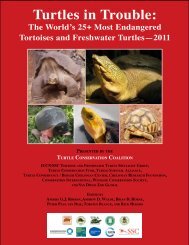Create successful ePaper yourself
Turn your PDF publications into a flip-book with our unique Google optimized e-Paper software.
an increase in wolf density, with negative implications for caribou<br />
due to their susceptibility to predation (Bowman et al. 2010). This<br />
should have implications for current cervid management and zoning<br />
in Ontario’s Far North (Appendix 3). While the increased moose<br />
density projected in our study may be moderated by density-dependent<br />
mortality factors, other studies support the finding that moose<br />
populations are likely to expand into the Far North (Varrin et al.<br />
2007, Rempel 2011). Climate change also has important implications<br />
for ungulate health because of the predicted expansion of deer<br />
(Odocoileus spp.) and meningeal worm (Paralaphostrongylus tenius)<br />
into northern ecosystems and changes to moose tick (Dermacentor<br />
albipictus) dynamics. (Varrin et al. 2007). Conserving wide-ranging<br />
species in the face of climate change will be aided by maintenance of<br />
intact landscapes, due to their roles in maintaining resiliency in the<br />
face of climate change and land use as well as facilitating range shifts<br />
(e.g., Hansen et al. 2010). Future scenario analyses could further<br />
explore the consequences of climate change by incorporating dynamics<br />
such as increased natural disturbance rate, altered predator-prey<br />
dynamics caused by shifts in species range (e.g., implications of<br />
moose population expansion to predation of caribou by wolves,<br />
implications of warming summers and disease dynamics on moose),<br />
and reduced habitat suitability for cold water species such as lake<br />
trout (Salvelinus namaycush) and brook trout (Salvelinus fontinalis)<br />
(Gunn and Snucins 2010).<br />
In contrast to their simulated decline in the southern portion of the<br />
study area, wolverine and caribou appeared relatively resilient under<br />
our conservative scenario of expanding land use north of the allocation<br />
limit. Habitat was adversely affected in proximity to anthropogenic<br />
footprints, but the low density of these prevented widespread<br />
risk. The limited spatial extent of simulated wildlife impacts in the<br />
north suggests that economic growth in the region can be compatible<br />
with persistence of sensitive wildlife populations. However, this<br />
result must be interpreted with caution because our analysis may<br />
underestimate the extent and intensity of land use north of the AOU<br />
for two reasons.<br />
• The prevailing pattern globally is that the creation of infrastructure<br />
such as roads and transmission corridors not only facilitates<br />
planned projects but, more generally, serves to open up previously<br />
inaccessible regions and tends to stimulate further development<br />
and roads (Far North Science Advisory Panel 2010, p. xiii).<br />
Specifically, the Far North Science Advisory Panel reviewed the<br />
implications of roads and transmission corridors in Ontario’s Far<br />
A Fork in the Road: Future Development in Ontario’s Far North<br />
45







![RaLand / SeaScape [PDF] - Wildlife Conservation Society](https://img.yumpu.com/49974326/1/190x245/raland-seascape-pdf-wildlife-conservation-society.jpg?quality=85)









